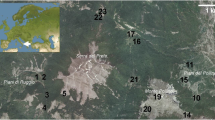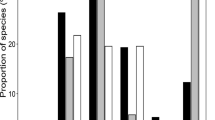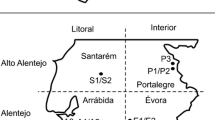Abstract
Although butterfly declines have been reported across Europe, no assessment based on detailed quantitative data has ever been made for any extensive area in the Mediterranean Basin. In 1994, a Butterfly Monitoring Scheme was launched in Catalonia (NE Spain), and in 2005 a similar, albeit much smaller, scheme started in the neighbouring Pyrenean country of Andorra. Here we provide a first thorough assessment of butterfly trends in both areas for the last 15 years. Several patterns emerged, above all a worrying decline of a substantial part of the fauna. It was also evident that habitat specialists are experiencing greater declines than habitat generalists, thereby butterfly communities becoming progressively dominated by common species. However, habitat indicators based on characteristic species also revealed that trends are actually associated with habitat types, grassland and scrub specialists declining strongly but woodland specialists showing a marginal increase. These differences are certainly related to profound landscape changes, mainly a dramatic reduction of semi-natural grasslands and open Mediterranean scrub, and a major increase in woodlands. The general effect of climatic warming on butterfly populations was investigated by using the temperature community index (CTI) approach. The thermal structure of butterfly communities remained very stable over time, except in one case where, contrary to the expectations, a significant negative trend in the CTI was noted. However, this surprising result can be explained by taking into account the above-reported pattern of butterfly communities becoming dominated by common species, characterized by low thermal indices in comparison with declining Mediterranean specialists.




Similar content being viewed by others
References
Blondel J, Aronson J (1999) Biology and wildlife of the mediterranean region. Cambridge University Press, Cambridge
Botham MS, Brereton TM, Middlebrook I, Cruickshanks KL, Harrower C, Beckmann B, Roy DB (2008) United Kingdom butterfly monitoring scheme report for 2008. CEH Wallingford
Brotons Ll, Herrando S, Estrada J, Pedrocchi V (2004) Patrons generals dels canvis en la distribució de les espècies i l’ús del sòl en el període entre els dos atles. In: Estrada J, Pedrocchi V, Brotons Ll, Herrando S (eds) Atles dels ocells nidificants de Catalunya 1999–2002. Institut Català d’Ornitologia/Lynx Edicions, Barcelona, pp 567–581
Debussche M, Lepart J, Dervieux A (1999) Mediterranean landscape changes: evidence from old postcards. Glob Ecol Biogeogr 8:3–15
Dennis RLH, Schmitt T (2009) Faunal structures, phylogeography and historical inference. In: Settele J, Shreeve T, Konvicka M, Van Dyck H (eds) Ecology of butterflies in Europe. Cambridge University Press, Cambridge, pp 250–280
Devictor V, Julliard R, Couvet D, Jiguet F (2008) Birds are tracking climate warming, but not fast enough. Proc R Soc Lond B 275:2743–2748
Devictor V, van Swaay CAM, Brereton T, Brotons Ll, Chamberlain D, Heliölä J, Herrando S, Julliard R, Kuussaari M, Lindström A, Reif J, Roy D, van Strien A, Settele J, Schweiger O, Stefanescu C, Vermouzek Z, van Turnhout C, Wallis de Vries M, Wynhoff I, Jiguet F (submitted) Climate change induces desynchronization between European birds and butterflies
González-Megías A, Menéndez R, Roy D, Brereton T, Thomas CD (2008) Changes in the composition of British butterfly assemblages over two decades. Glob Change Biol 14:1464–1474
Gordo O, Sanz JJ (2005) Phenology and climate change: a long-term study in a Mediterranean locality. Oecologia 146:484–495
Gregory RD, van Strien A, Vorisek P, Gmelig Meyling AW, Noble DG, Foppen RPB, Gibbons DW (2005) Developing indicators for European birds. Phil Trans R Soc B 360:269–288
Guirado M, Pino J, Rodà F (2007) Comparing the role of site disturbance and landscape properties on understory species richness in fragmented periurban Mediterranean forests. Landsc Ecol 22:117–129
Heikkinen RK, Luoto M, Leikola N, Pöyry J, Settele J, Kudrna O, Marmion M, Fronzek S, Thuiller W (2010) Assessing the vulnerability of European butterflies to climate change using multiple criteria. Biodivers Conserv 19:695–723
Hill JK, Collingham YC, Thomas CD, Blakeley DS, Fox R, Moss D, Huntley B (2001) Impacts of landscape structure on butterfly range expansion. Ecol Lett 4:313–321
Julliard R, Clavel J, Devictor V, Jiguet F, Couvet D (2006) Spatial segregation of specialists and generalists in bird communities. Ecol Lett 9:1237–1244
Koh LP, Sodhi NS, Brook BW (2004) Ecological correlates of extinction proneness in tropical butterflies. Conserv Biol 18:571–1578
Krauss J, Bommarco R, Guardiola M, Heikkinen RK, Helm A, Kuussaari M, Lindborg R, Öckinger E, Pärtel M, Pino J, Pöyry J, Raatikainen RM, Sang A, Stefanescu C, Teder T, Zobel M, Steffan-Dewenter I (2010) Habitat fragmentation causes immediate and time-delayed biodiversity loss at different trophic levels. Ecol Lett 13:597–605
Mattila N, Kaitala V, Komonen A, Kotiaho JS, Päivinen J (2006) Ecological determinants of distribution decline and risk of extinction in moths. Conserv Biol 20:1161–1168
Menéndez R, González-Megías A, Hill JK, Braschler B, Willis SG, Collingham Y, Fox R, Roy DB, Thomas CD (2006) Species richness changes lag behind climate change. Proc R Soc Lond B 273:1465–1470
Merrill RM, Gutiérrez D, Lewis OT, Gutiérrez J, Díez SB, Wilson RJ (2008) Combined effects of climate and biotic interactions on the elevational range of a phytophagous insect. J Anim Ecol 77:145–155
Moss D, Wyatt B, Cornaert MH, Roekaerts M (1990) CORINE Biotopes. The design, compilation and use of an inventory of sites of major importance for nature conservation in the European Community. Directorate-General Environment, Nuclear Safety and Civil Protection, Luxembourg
Myers N, Mittermeier RA, Mittermeier CG, da Fonseca GAB, Kent J (2000) Biodiversity hotspots for conservation priorities. Nature 403:853–858
Pannekoek J, van Strien AJ (2005) TRIM 3 manual. Trends and indices for monitoring data. CBS, Statistics Netherlands, Voorburg, Netherlands Freely available via www.ebcc.info
Peñuelas J, Filella I, Comas P (2002) Changed plant and animal life cycles from 1952 to 2000 in the Mediterranean region. Glob Change Biol 8:1–14
Petit S, Firbank L, Wyatt B, Howard D (2001) MIRABEL: models for integrated review and assessment of biodiversity in European landscapes. Ambio 30:81–88
Pino J, Rodà F, Basnou C, Guirado M (2009) El canvi ambiental a la Mediterrània: la perspectiva del paisatge. In: Barriocanal C, Varga D, Vila J (eds) Canvi ambiental global: una perspectiva multiescalar. Quaderns de Medi Ambient, 1. Documenta Universitaria, Girona, pp 91–102
Pollard E, Yates T (1993) Monitoring butterflies for ecology and conservation. Chapman and Hall, London
Pollard E, van Swaay CAM, Stefanescu C, Lundsten KE, Maes D, Greatorex-Davies JN (1998) Migration of the painted lady butterfly Cynthia cardui in Europe: evidence from monitoring. Divers Distrib 4:243–253
Polus E, Vandewoestijne S, Choutt J, Baguette M (2007) Tracking the effects of one century of habitat loss and fragmentation on calcareous grassland butterfly communities. Biodivers Conserv 16:3423–3436
Pöyry J, Luoto M, Heikkinen RK, Kuussaari M, Saarinen K (2009) Species traits explain recent range shifts of Finnish butterflies. Glob Change Biol 15:732–743
Preiss E, Martin JL, Debussche M (1997) Rural depopulation and recent landscape changes in a Mediterranean region: consequences to the breeding avifauna. Landsc Ecol 12:51–61
Stefanescu C (2001) The nature of migration in the red admiral butterfly Vanessa atalanta: evidence from the population ecology in its southern range. Ecol Entom 26:525–536
Stefanescu C, Peñuelas J, Filella I (2003) Effects of climatic change on the phenology of butterflies in the northwest Mediterranean basin. Glob Change Biol 9:1494–1506
Stefanescu C, Herrando S, Páramo F (2004) Butterfly species richness in the north-west Mediterranean basin: the role of natural and human-induced factors. J Biogeogr 31:905–915
Stefanescu C, Carnicer J, Peñuelas J (2010) Determinants of Mediterranean butterfly species richness: the negative synergistic forces of climate and habitat change. Ecography. doi:10.1111/j.1600-0587.2010.06264.x
Thomas JA (1984) The conservation of butterflies in temperate countries: past efforts and lessons for the future. In: Vane-Wright RI, Ackery P (eds) Biology of butterflies. Symposium of the royal entomological society 11. Academic Press, New York, pp 333–353
Thomas JA (1991) Rare species conservation: case studies of European butterflies. In: Spellerberg IF, Goldsmith FB, Morris MG (eds) The scientific management of temperate communities for conservation. BES Symposium (1989). Blackwell Scientific Publications, Oxford, pp 149–197
van Dyck H, van Strien AJ, Maes D, van Swaay CAM (2009) Declines in common, widespread butterflies in a landscape under intense human use. Conserv Biol 23:957–965
van Swaay CAM, Plate CL, van Strien AJ (2002) Monitoring butterflies in the Netherlands: how to get unbiased indices. Proc Exper Appl Entomol, NEV (Amsterdam) 13:21–27
van Swaay CAM, Warren M, Loïs G (2006) Biotope use and trends of European butterflies. J Insect Conserv 10:189–209
van Swaay CAM, Nowicki P, Settele J, van Strien AJ (2008) Butterfly monitoring in Europe: methods, applications and perspectives. Biodivers Conserv 17:3455–3469
Wallis de Vries MF, Poschlod P, Willems JH (2002) Challenges for the conservation of calcareous grasslands in northwestern Europe: integrating the requirements of flora and fauna. Biol Conserv 104:265–273
Warren MS, Hill JK, Thomas JA, Asher J, Fox R, Huntley B, Roy DB, Telfer MG, Jeffcoate S, Harding P, Jeffcoate G, Willis SG, Greatorex-Davies JN, Moss D, Thomas CD (2001) Rapid responses of British butterflies to opposing forces of climate and habitat change. Nature 414:65–69
Wilson RJ, Gutiérrez D, Gutiérrez J, Martínez D, Agudo R, Montserrat VJ (2005) Changes to the elevational limits and extent of species ranges associated with climate change. Ecol Lett 8:1138–1146
Wilson RJ, Gutiérrez D, Gutiérrez J, Monserrat VJ (2007) An elevational shift in butterfly species richness and composition accompanying recent climate change. Glob Change Biol 13:1873–1887
Acknowledgments
Thanks are due to all the recorders who contribute data to the Catalan Butterfly Monitoring Scheme and BMSAnd. The Butterfly Monitoring Scheme in Catalonia is funded by the Departament de Medi Ambient i Habitatge de la Generalitat de Catalunya. The Diputació de Barcelona, Patronat Metropolità Parc de Collserola and Fundació Caixa de Catalunya have also given financial support to this project. The BMSAnd project is supported by the Centre d’Estudis de la Neu i la Muntanya d’Andorra (CENMA), from the Institut d’Estudis Andorrans (IEA).
Author information
Authors and Affiliations
Corresponding author
Electronic supplementary material
Below is the link to the electronic supplementary material.
Table S1
Species detected in the CBMS, with the minimum, maximum and average number of sites at which they were annually recorded. Taxonomy as per Karsholt and Razowski (1996), with slight variations. Karsholt O, Razowski J (1996) The Lepidoptera of Europe. A Distribution Checklist. Apollo Books, Stenstrup. (DOC 467 kb)
Fig. S1
(a) Number of sites where butterflies were recorded each year; (b) Distribution of the complete annual series available (1994–2008) for all the sites used for calculating butterfly trends. (DOC 25 kb)
Rights and permissions
About this article
Cite this article
Stefanescu, C., Torre, I., Jubany, J. et al. Recent trends in butterfly populations from north-east Spain and Andorra in the light of habitat and climate change. J Insect Conserv 15, 83–93 (2011). https://doi.org/10.1007/s10841-010-9325-z
Received:
Accepted:
Published:
Issue Date:
DOI: https://doi.org/10.1007/s10841-010-9325-z




